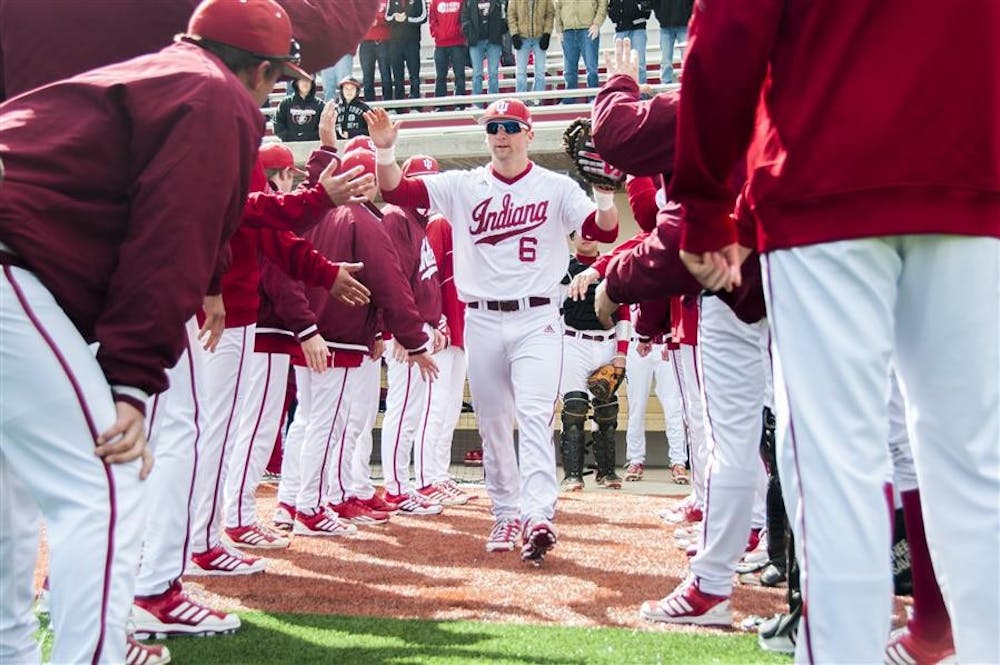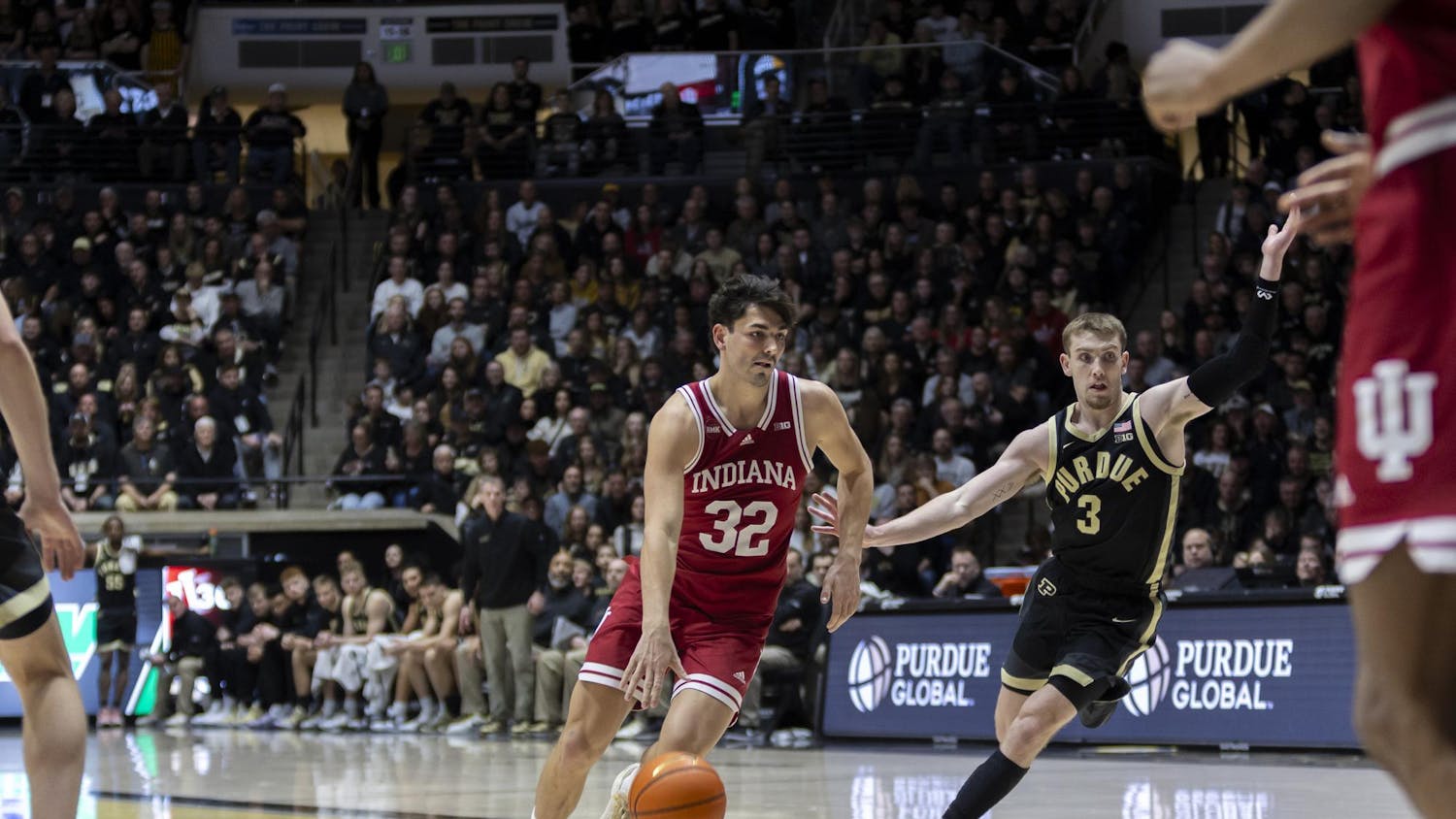Last season was the best year in the history of IU baseball. And a year of many firsts.
It was the first time IU had ever been ranked in the polls. The Hoosiers finished the year ranked No. 7 by Baseball America.
It was the first year of Bart Kaufman Field.
It was the first time IU advanced to the College World Series.
This season, the Hoosiers will try for another first: win the College World Series.
It would be the first time a Big Ten team has been national champion since Ohio State won in 1966.
The Hoosiers won’t be sneaking up on anybody this year. They open up the year ranked No. 3 by Baseball America with expectations of winning the national title, IU Coach Tracy Smith said.
“This group — from the end of last year — they said we have some unfinished business to do,” he said.
Last year’s Bad Luck
Even though IU finished the season with 49 wins (no other Big Ten team had more than 35), they were the second-unluckiest team in the conference.
The Pythagorean Theorem of Baseball is an equation developed by baseball statistics pioneer Bill James.
The theorem, which uses elements of the Pythagorean Theorem, is used to calculate how many games a team should have won compared to how games it actually won.
The equation uses runs scored and runs allowed. It is designed to be a better indicator of how a team truly performed than standard wins and losses.
Consider the following example.
Team A wins three games by close scores of 5-4, 3-2 and 2-0. Their win record is 3-0.
Team B wins two games by big scores of 11-2 and 6-0. But they also lose a close game 4-3. So their win record is 2-1.
If one were to look only at the teams’ overall win/loss records, one might say Team A is better because of its better record.
But, in actuality, Team B is a more dominant team and was “unlucky” in one game, losing a close battle.
The Pythagorean Theorem of Baseball takes into account how a team did — not based on the standard win/loss records — but a more specific focus on how the team actually played.
Last year IU won 49 games. But, according to the PTB, IU should have won 51.7 games.
So the team had a PTB number of +2.7, meaning they should have won 2.7 more games than they actually did.
Only one other team in the Big Ten had a higher PTB number: Northwestern had a +3.2 PTB.
Not only did the Hoosiers have the best record by a significant margin, but that gap should have been even larger.
This bodes well for the Hoosiers this year. Teams tend to regress toward the mean, or “average out” the next year if they have a high PTB number.
Unlucky teams will become luckier, and luckier teams will become unluckier.
Every national pundit predicts the Hoosiers will win the Big Ten fairly easily, as does the Pythagorean Theorem of Baseball.
Replacing production
The Hoosiers will need players to step up after losing three significant contributors up the middle of the field.
IU lost shortstop Michael Basil and center fielder Justin Cureton to graduation and starting pitcher Aaron Slegers to the MLB draft.
Slegers was the Big Ten Pitcher of the Year last season, boasting a 9-2 record with a 2.04 ERA.
The 6-foot-10 Minnesota Twins prospect was the third starter for IU, pitching most Sunday games for weekend series.
Basil was a four-year starter at shortstop and one of the main leaders of the team, Smith said.
The speedy Cureton was the leadoff hitter and one of the Hoosiers’ best defensive players in center field.
The expected replacements will be sophomore Nick Ramos at shortstop, junior Will Nolden at center field and sophomore Will Coursen-Carr in the pitching rotation, Smith said.
These three players saw significant playing time last year in different roles than they’ll have this season, and performed well.
To figure out how these players will step up statistics they must be evaluated one by one.
Shortstop
Basil had 49 RBIs last year compared to Ramos’ 23. However, Basil had 243 at-bats compared to Ramos’ 92.
Basil had more opportunities to swing the bat, so his statistics should be much higher than Ramos.
If Ramos had the same amount of at-bats as Basil last year, he would have had 61 RBIs. That’s a 24-percent increase in RBIs from the shortstop position from Basil to Ramos.
According to the extrapolated statistics, Ramos would have hit 10.7 home runs, compared to Basil’s three home runs.
The one major drop off from Basil to Ramos is batting average and on-base percentage.
Basil hit .313 last year with a staggering .402 on-base percentage.
Ramos hit at a significantly lower rate. He had a .228 average with a woeful .265 on-base percentage.
There is a 27 percent drop off in batting average and a 34 percent drop off in on-base percentage from Basil to Ramos.
While Ramos had more power, Basil got on base at a much higher rate.
He was also more of a threat on the base paths. Basil stole seven bases last year. Ramos had zero.
Center field
Cureton was known more for his glove than his bat, so his hitting statistics were less than stellar.
Nolden was a much better hitter last year as a sophomore than Cureton was as a senior.
Cureton hit .216 but had a respectable .335 on-base percentage.
Nolden hit 40 percent higher at .303 and got on base 21 percent more often with an impressive .404 on-base percentage.
But IU will miss Cureton’s speed.
Cureton stole 22 bases last year, which led the team and was one away from the most in the Big Ten.
Extrapolating Nolden’s statistics shows he would have stolen only 9.5 bases given the same number of opportunities as Cureton.
That’s a 57-percent drop off in stolen bases. Also, it’s tough to quantify the impact Cureton had in the field.
Third Starter
Last year saw the culmination of Aaron Slegers’ career. He was plagued by injuries his first two seasons at IU, but last year he was healthy and set the conference on fire.
He was the Big Ten Pitcher of the Year, he was 9-2 with a 2.04 ERA and he held batters to a .260 batting average.
With Slegers now pitching in the Minnesota Twins farm system, the pitcher who will replace him appears to be Will Coursen-Carr.
“We’re looking for him to step up and be that consistent guy early in the year,” Smith said of Coursen-Carr, “... but he should be a weekend guy for us.”
Assuming Coursen-Carr eventually gets the weekend nod, the Hoosiers will be getting a pitcher who performed well last year.
As the primary mid-week starter, Coursen-Carr excelled. He was 5-0 with a 1.93 ERA.
However, Slegers usually faced stiffer competition, as he was the weekend starter.
The main difference between him and Slegers is the strikeout-to-walk ratio.
Slegers had more strikeouts, but he pitched 106 innings compared to Coursen-Carr’s 65 1/3.
If he had pitched as many innings as Slegers, Coursen-Carr would have had 60 strikeouts. Slegers had 59.
The big difference between the two is the walks given up.
Slegers had only 17 walks, while Coursen-Carr’s extrapolated statistics suggest he would have had 44 walks. That’s a 158-percent increase in walks issued from Slegers to Coursen-Carr.
To match Slegers’ efficiency, Coursen-Carr will have to cut down on the walks.
Coursen-Carr, Ramos and Nolden also had an offseason to develop into better players.
Therefore, these statistics shouldn’t be taken as absolute dogma, but they can be used to create a preliminary sketch of the kind of production IU is set to lose or gain.
Follow reporter
Evan Hoopfer on Twitter
@EvanHoopfer.
A statistical look at IU baseball

Get stories like this in your inbox
Subscribe



